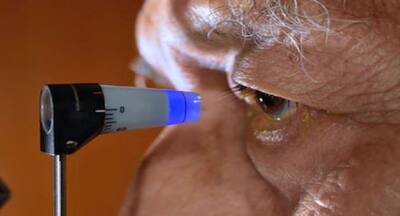Don’t Miss Out on the Latest Updates.
Subscribe to Our Newsletter Today!
New AI test can diagnose glaucoma at an early stage: Things you need to know about this eye disease

Using AI, researchers have developed a quick test to identify which people with glaucoma are at risk of rapid progression to blindness. Read to know more about this eye disease
Glaucoma is one of leading causes of irreversible blindness among people over the age of 60. Currently, it affects over 60 million people worldwide and is predicted to double by 2040 as the global population ages. Loss of sight in glaucoma is caused by the death of cells in the retina, at the back of the eye.
Thanks to Artificial Intelligence (AI), doctors may now be able to identify early signs of glaucoma and provide timely treatment to save the eyesight of people with the disease.
Using AI, researchers have developed a quick test to identify which people with glaucoma are at risk of rapid progression to blindness. The AI-based test can detect glaucoma progression 18 months earlier than the current gold standard method, according to the study published in the journal Expert Review of Molecular Diagnostics.
Also Read
"Being able to diagnose glaucoma at an earlier stage, and predict its course of progression, could help people to maintain their sight, as treatment is most successful if provided at an early stage of the disease," said study first author Eduardo Normando from Imperial College London.
How the test works?
The test is called DARC (Detection of Apoptosing Retinal Cells). It involves injecting into the bloodstream (via the arm) a fluorescent dye that attaches to retinal cells and illuminates those that are in the process of apoptosis, a form of programmed cell death. The damaged cells appear bright white when viewed in eye examinations -- the more damaged cells detected, the higher the DARC count.
One big challenge with evaluating eye diseases is that specialists often disagree when viewing the same scans. So, the researchers have incorporated an AI algorithm into their method.
In the Phase II clinical trial of DARC, the AI was used to assess 60 of the study participants -- 20 with glaucoma and 40 healthy control subjects. They were followed up for 18 months after the main trial period to see whether their eye health had deteriorated.
The researchers were able to accurately predict progressive glaucomatous damage 18 months earlier that the current gold standard OCT retinal imaging technology. They found that every patient with a DARC count over a certain threshold have progressive glaucoma at follow-up.
These results indicate that DARC could be used as a biomarker when combined with the AI-aided algorithm, noted lead researcher Francesca Cordeiro from University College London (UCL) Institute of Ophthalmology.
All you need to know about this disease
Glaucoma can damage your optic nerve, which supplies visual information to your brain from your eyes. This disease is usually, but not always, caused by abnormal high pressure inside your eye.
The increased pressure can erode your optic nerve tissue and may eventually lead to vision loss or even blindness. It is not quite clear what leads to increased pressure in your eye. However, some factors that may play a role include:
- dilating eye drops
- blocked or restricted drainage in your eye
- medications, such as corticosteroids
- poor or reduced blood flow to your optic nerve
- high or elevated blood pressure
Symptoms of glaucoma
If diagnosed early, additional vision loss may be prevented. Primary open-angle glaucoma and acute-angle closure glaucoma are two common types of the disease.
In primary open-angle glaucoma, one may not experience any signs or symptoms except gradual vision loss. Therefore, it's important to get yearly comprehensive eye exams to see any changes in your vision. Acute-angle closure glaucoma or narrow-angle glaucoma, on the other hand, is a medical emergency. If you the following symptoms, see your doctor immediately:
- severe eye pain
- nausea
- vomiting
- redness in your eye
- sudden vision disturbances
- seeing coloured rings around lights
- sudden blurred vision
According to the World Health Organization (WHO), glaucoma is the second leading cause of blindness around the world. The risk factors for glaucoma include: age (people over 60 are at increased risk), ethnicity (African-Americans or people of African descent are at higher risk), eye problems, family history, medical history (diabetics and those with high blood pressure and heart disease), use of certain medicine like corticosteroids, etc.
(With inputs from IANS)


